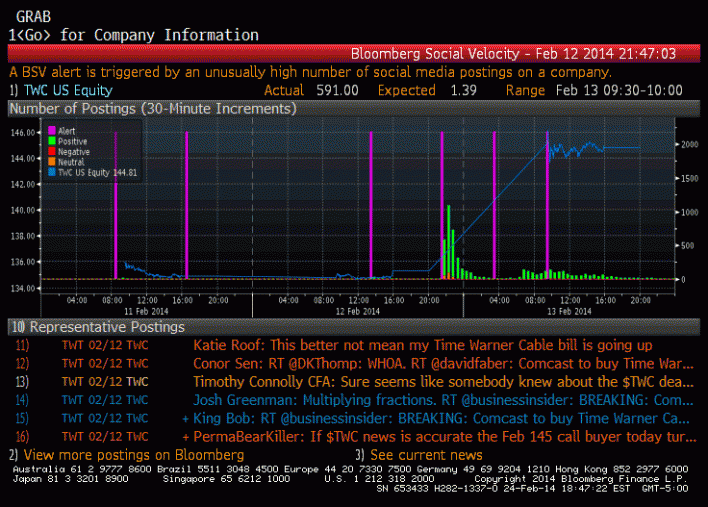
Image: Solarfeeds.com
It used to be the case that financial firms would block social media services such as Twitter on their systems to prevent their employees leaking sensitive information – and also to prevent them from timewasting at work. This was an effective strategy, with just one fairly major issue – Twitter was becoming a hugely important generator of market signals, with companies and reporters using it to reveal important news.
Traders with Twitter blocked on their systems would then have to rely on second-hand information, such as news reports that mentioned important tweets. There have been several incidences of tweets causing major market movements, such as Apple shares jumping nearly 5% after two tweets from famed activist investor Carl Icahn. Another was the infamous ‘hack crash‘, in which the Associated Press Twitter account was hacked and a tweet posted about an explosion at the White House, which momentarily wiped billions off the value of US stocks before the hoax was revealed.
But while hearing about important company news first on Twitter is one way for traders to leverage social media, it is not the only one. In particular, the mass of data produced by Twitter, if filtered properly, can be a good indicator of how most people are feeling about certain financial instruments (such as stocks) or the market as a whole, and this can often be a reliable indicator of future price trends.
This type of activity, which involves using huge cloud computing power to sift through vast amounts of data and analyse it, is known as sentiment analysis, and leading trading services provider Bloomberg has just launched its own sentiment analysis tools to tell traders about spikes in positive or negative chatter on Twitter.
“If Carl Icahn tweets about Apple, you can’t wait for some journalist to write it up,” said Brian Rooney, Bloomberg’s head of product for news. “As social moved into the financial sphere, it became absolutely clear we had to track it.”
Last spring, Bloomberg responded to this trend by introducing a Twitter compartment that stands alongside the standard financial data and other news feeds that have long been a feature of the firm’s famous trading terminals. This feature, which came out shortly after the SEC ruled that companies such as Netflix were indeed allowed to use social media to disclose market-moving information, provides a way for employees to read but not send tweets.
Recently, Bloomberg have evolved the technology by adding a sentiment analysis tool that alerts traders to any spikes in social media activity around specific stocks or keywords, and shows whether the news is likely to be good or bad.

Image: Gigaom.com
The purple spikes on the chart are known as ‘velocity alerts’, and these indicate a burst of social media activity around a stock, with green bars indicating positive sentiment and red bars (often nested with the green) indicating negative sentiment. In this case, velocity and positive sentiment news alerts for Time Warner Cable appeared on the Bloomberg screen within 90 seconds of the initial tweet from CNBC.
In an effort to ascertain the public mood about a stock on Twitter, Bloomberg uses sentiment analysis tools that were developed in-house. With over 3,000 engineers with core competencies such as machine learning, auto-translation, and natural language processing, Bloomberg had all the expertise they needed to produce the tool without having to go to a third party. However, like all analytics companies, Bloomberg has to use third party data providers such as Datasift and GNIP for access to the full firehose of Twitter information.
One thing that Bloomberg has noticed from trialling the system is that Twitter has something of a positive bias when it comes to company news. One of the main reasons for this is that the language and expressions that are used to describe deals are usually favourable, or neutral.
“We have found that Twitter is biased to the positive, but that can make negative tweets more important,” he said, and added that the firm may calibrate its sentiment analysis algorithms to take this bias into account.
The impact of Twitter on the market is also indicative of the impact that big data is having on the financial services industry.
“The challenge used to be ‘where do I get information?’ Now, it’s about curating and making the information actionable.”
Read More:
What is the best definition of economic data?
Tradersdna is a leading digital and social media platform for traders and investors. Tradersdna offers premiere resources for trading and investing education, digital resources for personal finance, market analysis and free trading guides. More about TradersDNA Features: What Does It Take to Become an Aggressive Trader? | Everything You Need to Know About White Label Trading Software | Advantages of Automated Forex Trading








